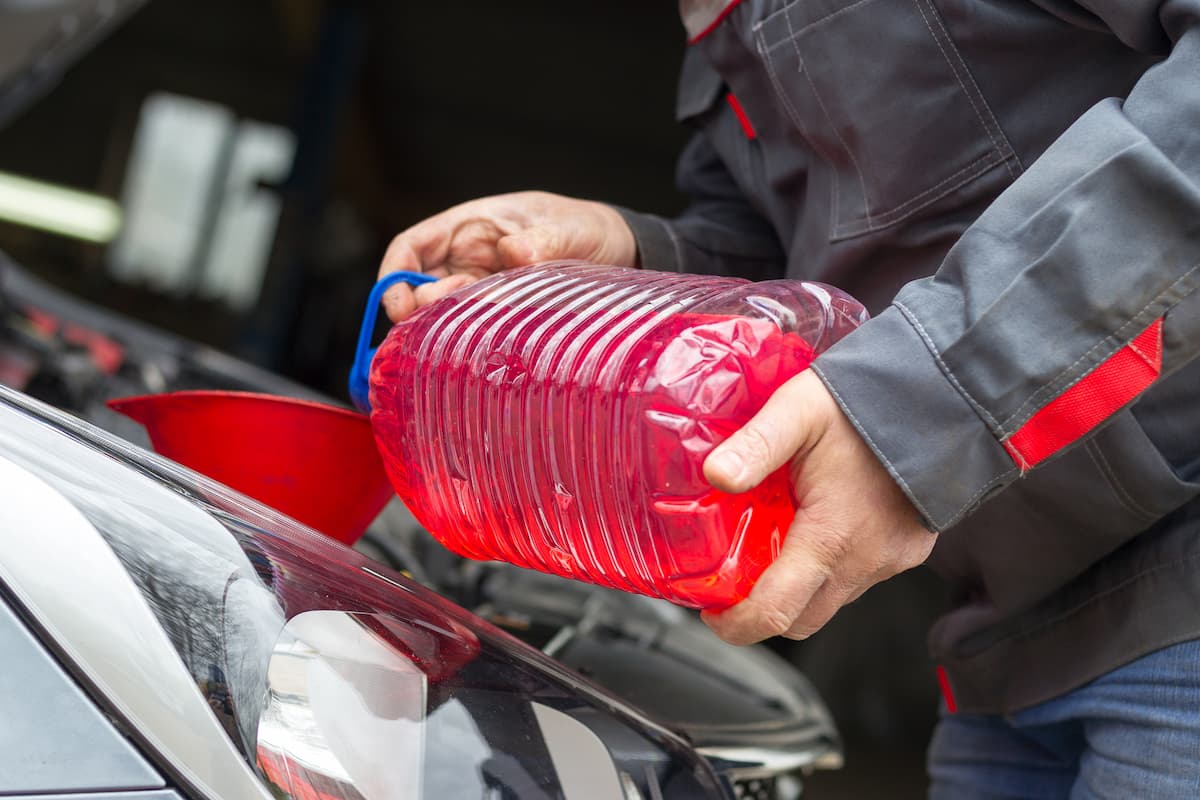Can You Mix Transmission Fluid With Engine Oil?
In the past, flushing an engine by mixing transmission fluid with engine oil was customary.
However, with technological advancements in the automobile and energy industries, the process is more destructive than beneficial today.
Mixing transmission fluid with engine oil has little to no effect. You risk wearing out your engine if both lubricants are of equal amounts and have different base oils. Take precautions and use an engine flush instead.
Car Performance After Mixing Transmission Fluid With Engine Oil

It’s good practice to avoid mixing transmission fluid with engine oil.
Depending on the components of each lubricant, mixing can do nothing – and you’ve wasted both fluids – or you can make your current problems worse or damage your engine irreparably.
Four things will determine whether your car’s performance deteriorates after mixing transmission fluid with engine oil:
- Oil volumes
- Base Oils
- Additives
- Viscosity.
Understanding each component helps avoid costly mistakes.
Oil Volumes
Mixing transmission fluid and engine oil in a 1:45 ratio won’t do much to your engine, especially if both lubricants are of the same mineral group. (A 1:45 ratio is approximately one teaspoon in one cup).
However, using a 1:1 or even 1:3 ratio poses a lot more risk, and you endanger your motor further if the underlying minerals differ.
Engine oil today is far from what it was. Over the years, several improvements to the formula have led to the addition of more cleaning agents in engine oil than in transmission fluid.
So, even if nothing happens to your engine in the short term, it may end up with more sludge which can impact performance and lead to engine failure.
Base Oils and Additives
Machine oils and lubricants are mainly comprised of base oils and additives.
Base oils are the underlying mineral or synthetic and comprise the largest proportion of the fluid.
Additives are “add-ons” specific to the machine part, with the 10%-12% in transmission fluid suited to your transmission and the 7%-10% in engine oil geared to your engine.
Additives improve base oils by:
- Bringing out present properties
- Subduing displeasing properties
- Adding new properties.
Examples of additives include:
- Anti-oxidants
- Detergents
- Demulsifiers
- Dispersants
- Friction Modifiers.
Additives and base oils are a team, and a calculated balance prevents the accumulation of deposits, dissolves gunk, reduces friction, and combats engine corrosion.
An alien substance like transmission fluid disrupts this relationship by adding different concentrations of base oils and additives.
Manufacturers ensure additive concentrations are equipment-specific, so even if your transmission fluid has the same base oils as your engine oil, you’ll rarely find both substances with similar additive concentrations.
Your best bet is to avoid the mix and use each lubricant for its specified use.
Viscosity
Viscosity is a measure of oil thickness. Proper oil thickness is essential for lubricating metal parts that may otherwise grind or stick together, preventing proper functioning.
Any changes to oil thickness can negatively impact the lubricant’s film strength, another essential component of effective lubrication.
In addition to thickness, film strength enhances the oil’s capacity to lubricate a machine part.
An increase in viscosity leads to an increase in film strength, which can lead to fluid friction.
Fluid friction is the amount of resistance within a liquid. If there’s an increase in friction, overheating occurs as the fluid’s molecules are so compressed the layers resist movement between each other.
Conversely, a decrease in viscosity decreases lubricant film strength. Overheating is also the outcome and occurs when moving parts come into contact.
Because of the differing underlying components (e.g., additives and contaminants), mixing lubricants like transmission fluid and engine oil may increase or decrease viscosity.
The Best Way to Recycle Transmission Fluid
The best way to recycle transmission fluid is by disposing of it in your city’s hazardous waste facility, not dumping it in your engine oil.
Hazardous waste facilities are centers where households and businesses dispose of controlled substances like pesticides and compressed gas tanks.
Transmission fluid must be disposed of properly because it’s flammable and has potential health hazards. Additionally, it can be dangerous when mixed with solvents, which are abundant in trash landfills.
Most recycling centers won’t accept transmission fluid (or motor oil, brake fluid, or antifreeze) if mixed or contaminated with another substance, so proper disposal is another good reason not to mix transmission fluid and engine oil.
Proper Disposal
Do not dispose of transmission fluid at home. Pouring it down the drain can block your drainage system and, in the worst-case scenario, start a fire.
Don’t pour the fluid into your toilet, sewer, or street drain either.
Most of all, don’t mix it with engine oil and other automotive fluids; otherwise, the waste facility will refuse to recycle it.
Inquire About Policies
If you’re lucky, your county’s waste facility will pick up the transmission fluid at your home, but this service isn’t available everywhere.
When you must drop off your fluid in person, it’s important to understand the policies and procedures at the waste management facility to avoid awkward or inconvenient situations.
The most important thing to double-check is the operating hours of the facility. In some areas, waste facilities are open seven days a week; however, in other jurisdictions, hours of operation can be significantly less.
Some facilities may only take certain waste products on certain days, so double-check your local facility’s website for further details.
You should also check for applicable fees and keep in mind that households are priced differently than businesses.
Finally, ensure your local waste facility accepts automotive fluids. If your local center doesn’t take them, inquire at your nearest automotive store.
Places like AutoZone and Firestone Auto Care may accept automotive fluids or may be able to tell you where to take yours.
Handle With Care
For safe disposal of transmission fluid, collect it with a drain pan and pour it into a leak-proof container.
Use a funnel to avoid spilling and ensure the container is clean.
Seal it when done, and store it away from children and animals.
For extra safety against leaks, place the container inside a larger vessel.
Keep the receptacle upright and next to you while driving, and watch your speed, so the fluids don’t spill.
Conclusion
Whether you’re looking to dispose of your transmission fluid or ante up your engine oil, mixing the two is never the answer.
Engine oil already contains effective cleaning and flushing agents, so there is no real benefit to adding transmission fluid.
In reality, mixing oils and greases can lead to costly and inconvenient engine problems.
To dispose of transmission fluid, take it to your nearest hazardous waste facility, where they will dispose of it safely.






